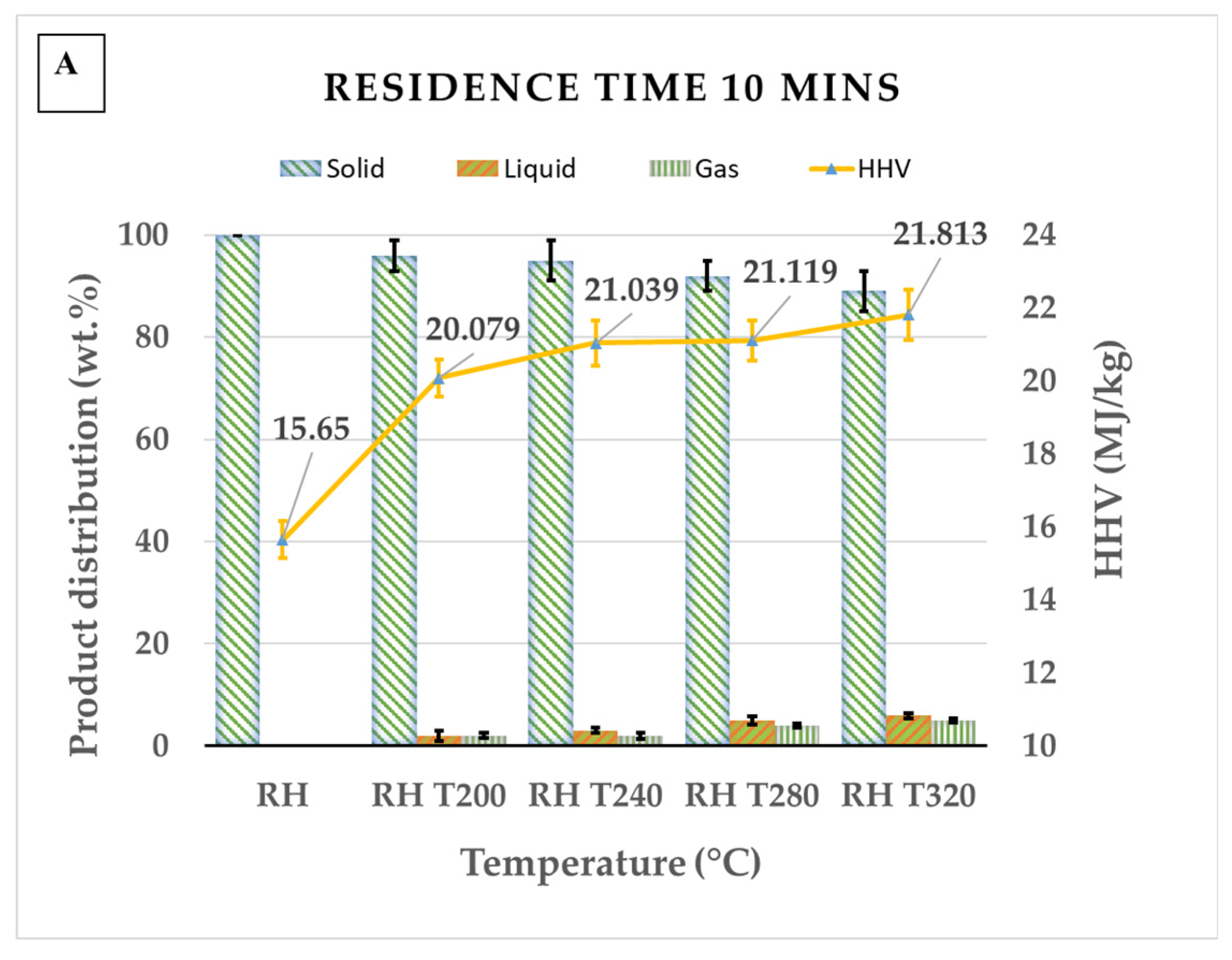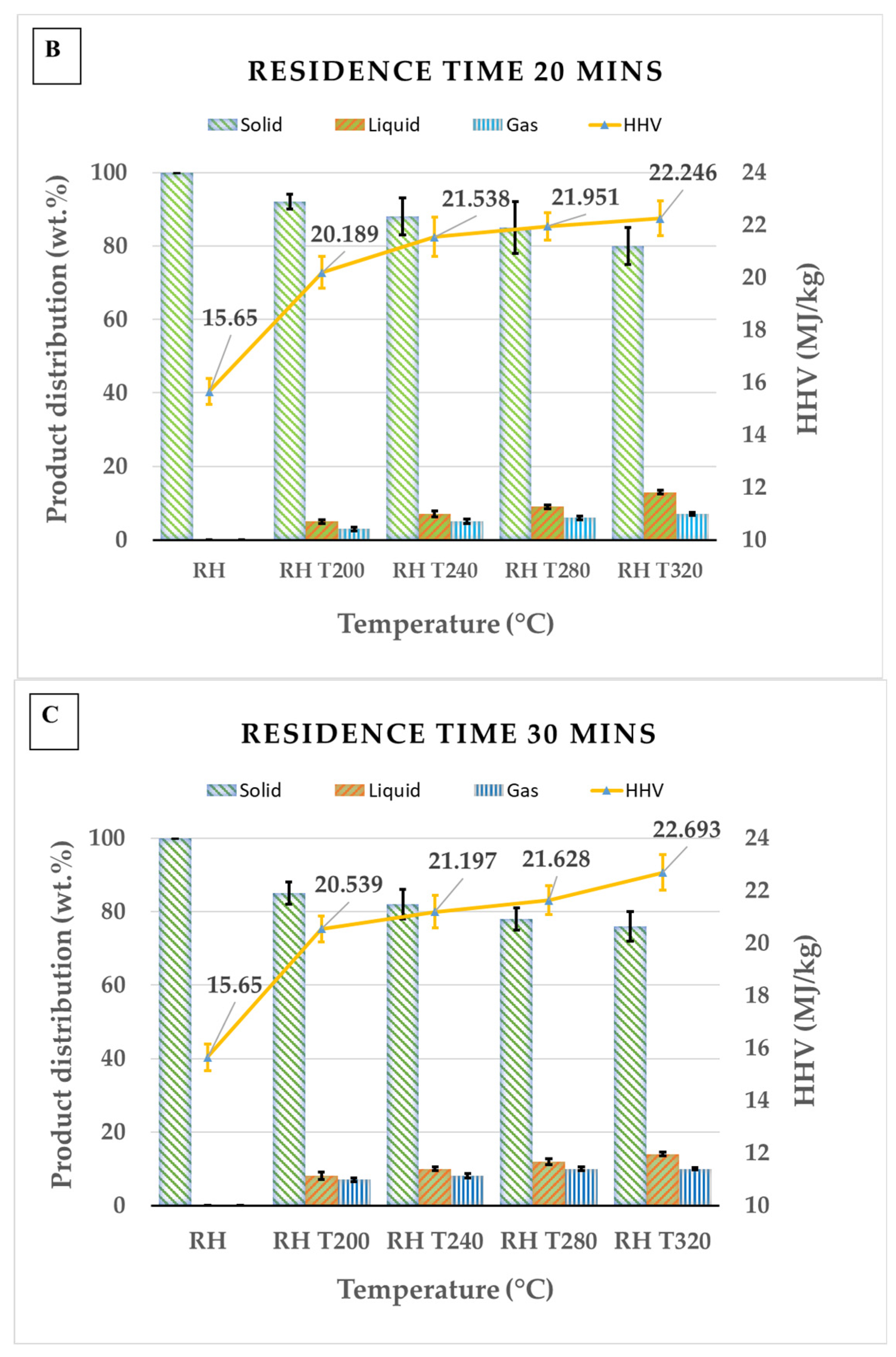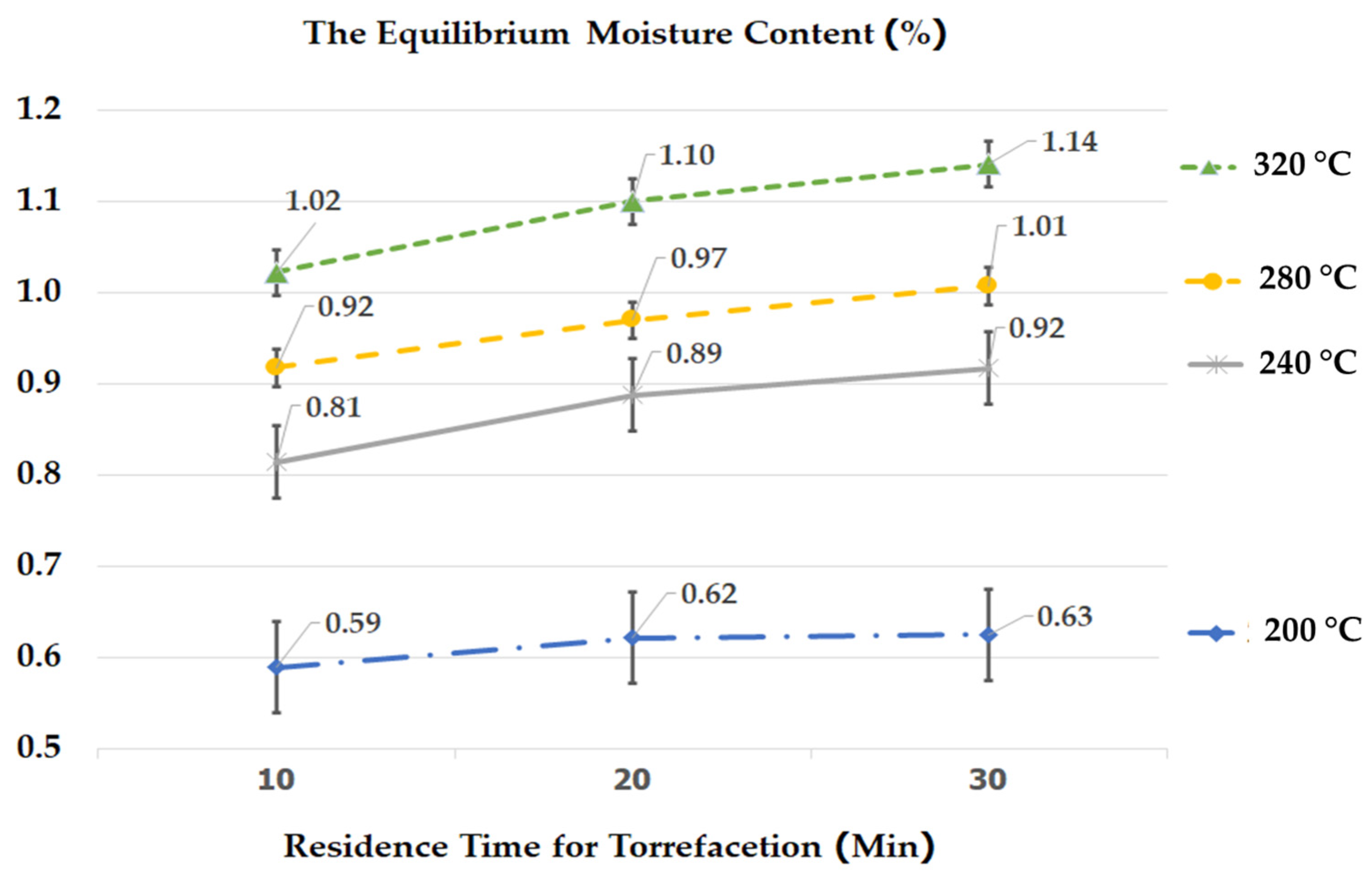Improvement of Higher Heating Value and Hygroscopicity Reduction of Torrefied Rice Husk by Torrefaction and Circulating Gas in the System
Abstract
1. Introduction
2. Materials and Methods
2.1. Raw Materials
2.2. Torrefaction Processes
2.3. Properties of Solid Products
3. Results and Discussion
3.1. Solid Product of Torrefaction
3.1.1. Proximate Analysis and Ultimate Analysis
3.1.2. Solid Yield and Higher Heating Value (HHV)
3.1.3. Equilibrium Moisture Content (EMC) Reabsorption Rate of the Experimental Samples
4. Conclusions
Author Contributions
Funding
Institutional Review Board Statement
Informed Consent Statement
Data Availability Statement
Acknowledgments
Conflicts of Interest
Abbreviations
| AC | Ash content |
| ASTM | American Society for Testing and Materials |
| C | Carbon |
| EMC | Equilibrium moisture content |
| FC | Fixed carbon |
| H | Hydrogen |
| HHV | Higher heating value |
| HRE | Hygroscopicity reduction extent |
| MC | Moisture content |
| N | Nitrogen |
| O | Oxygen |
| RH | Rice husk |
| S | Sulfur |
| VM | Volatile matter |
References
- Tsaktsira, M.; Tsoulpha, P.; Economou, A.; Scaltsoyiannes, A. Mitigation of Global Climate Change through Genetic Improvement of Resin Production from Resinous Pines: The Case of Pinus halepensis in Greece. Sustainability 2023, 15, 8052. [Google Scholar] [CrossRef]
- Han, J.; Yu, D.; Yu, X.; Liu, F.; Wu, J.; Zeng, X.; Yu, G.; Xu, M. Effect of the torrefaction on the emission of PM10 from combustion of rice husk and its blends with a lignite. Proc. Combust. Inst. 2019, 37, 2733–2740. [Google Scholar] [CrossRef]
- Wiyono, A.; Saw, L.H.; Anggrainy, R.; Husen, A.S.; Purnawan; Rohendi, D.; Gandidi, I.M.; Adanta, D.; Pambudi, N.A. Enhancement of syngas production via co-gasification and renewable densified fuels (RDF) in an open-top downdraft gasifier: Case study of Indonesian waste. Case Stud. Therm. Eng. 2021, 27, 101205. [Google Scholar] [CrossRef]
- Rahayu, N.; Normah, P.; Taher, T.; Mohadi, R.; Rachmat, A.; Lesbani, A. Effectivity of Indonesian Rice Husk as an Adsorbent for Removing Congo Red from Aqueous Solutions. Environ. Nat. Resour. J. 2021, 19, 255–265. [Google Scholar] [CrossRef]
- Bawa Susana, I.G.; Alit, I.B.; Okariawan, I.D.K. Rice husk energy rotary dryer experiment for improved solar drying thermal performance on cherry coffee. Case Stud. Therm. Eng. 2023, 41, 102616. [Google Scholar] [CrossRef]
- Alit, I.B.; Susana, I.G.B.; Mara, I.M. Thermal characteristics of the dryer with rice husk double furnace—Heat exchanger for smallholder scale drying. Case Stud. Therm. Eng. 2021, 28, 101565. [Google Scholar] [CrossRef]
- Chokphoemphun, S.; Eiamsa-ard, S.; Promvonge, P.; Chuwattanakul, V. Rice husk combustion characteristics in a rectangular fluidized-bed combustor with triple pairs of chevron-shaped discrete ribbed walls. Case Stud. Therm. Eng. 2019, 14, 100511. [Google Scholar] [CrossRef]
- Liu, X.; Yang, H.; Yang, J.; Liu, F. Application of Random Forest Model Integrated with Feature Reduction for Biomass Torrefaction. Sustainability 2022, 14, 16055. [Google Scholar] [CrossRef]
- Chen, D.; Gao, A.; Cen, K.; Zhang, J.; Cao, X.; Ma, Z. Investigation of biomass torrefaction based on three major components: Hemicellulose, cellulose, and lignin. Energy Convers. Manag. 2018, 169, 228–237. [Google Scholar] [CrossRef]
- Chen, D.; Gao, A.; Ma, Z.; Fei, D.; Chang, Y.; Shen, C. In-depth study of rice husk torrefaction: Characterization of solid, liquid and gaseous products, oxygen migration and energy yield. Bioresour. Technol. 2018, 253, 148–153. [Google Scholar] [CrossRef]
- Chen, W.-H.; Lin, B.-J.; Colin, B.; Chang, J.-S.; Pétrissans, A.; Bi, X.; Pétrissans, M. Hygroscopic transformation of woody biomass torrefaction for carbon storage. Appl. Energy 2018, 231, 768–776. [Google Scholar] [CrossRef]
- Chen, W.H. A study of hygroscopic property of biomass pretreated by torrefaction. Energy Procedia 2017, 158, 32–36. [Google Scholar] [CrossRef]
- Chen, D.; Chen, F.; Cen, K.; Cao, X.; Zhang, J.; Zhou, J. Upgrading rice husk via oxidative torrefaction: Characterization of solid, liquid, gaseous products and a comparison with non-oxidative torrefaction. Fuel 2020, 275, 117936. [Google Scholar] [CrossRef]
- Esteves, B.M.; Pereira, H.M. Wood Modification by Heat Treatment: A Review. BioResources 2009, 4, 370–404. [Google Scholar] [CrossRef]
- Hsin, C.W.; Jianghong, P.; Xiaotao, B. A state-of-the-art review of biomass torrefaction, densification and applications. Renew. Sustain. Energy Rev. 2015, 44, 847–866. [Google Scholar] [CrossRef]
- Singh, S.; Chakraborty, J.P.; Mondal, M.K. Torrefaction of woody biomass (Acacia nilotica): Investigation of fuel and flow properties to study its suitability as a good quality solid fuel. Renew. Energy 2020, 153, 711–724. [Google Scholar] [CrossRef]
- Junfeng, L.; Runqing, H.; Yanqin, S.; Jingli, S.; Bhattacharya, S.C.; Abdul Salam, P. Assessment of sustainable energy potential of non-plantation biomass resources in China. Biomass Bioenergy 2005, 29, 167–177. [Google Scholar] [CrossRef]
- Martín-Pascual, J.; Jódar, J.; Rodríguez, M.L.; Zamorano, M. Determination of the Optimal Operative Conditions for the Torrefaction of Olive Waste Biomass. Sustainability 2020, 12, 6411. [Google Scholar] [CrossRef]
- Nakason, K.; Khemthong, P.; Kraithong, W.; Chukaew, P.; Panyapinyopol, B.; Kitkaew, D.; Pavasant, P. Upgrading properties of biochar fuel derived from cassava rhizome via torrefaction: Effect of sweeping gas atmospheres and its economic feasibility. Case Stud. Therm. Eng. 2021, 23, 100823. [Google Scholar] [CrossRef]
- Kung, K.S.; Thengane, S.K.; Ghoniem, A.F. Functional mapping of torrefied product characteristics with index of torrefaction. Fuel Process. Technol. 2020, 202, 106362. [Google Scholar] [CrossRef]
- Liu, Y.; Rokni, E.; Yang, R.; Ren, X.; Sun, R.; Levendis, Y.A. Torrefaction of corn straw in oxygen and carbon dioxide containing gases: Mass/energy yields and evolution of gaseous species. Fuel 2021, 285, 119044. [Google Scholar] [CrossRef]
- Ma, L.; Wei, W.; Sun, F.; Shi, Y. Research on formation mechanism of typical low-temperature fouling layers in biomass-fired boilers. Case Stud. Therm. Eng. 2022, 35, 102076. [Google Scholar] [CrossRef]
- Mamvura, T.A.; Danha, G. Biomass torrefaction as an emerging technology to aid in energy production. Heliyon 2020, 6, e03531. [Google Scholar] [CrossRef] [PubMed]
- Ribeiro, J.; Godina, R.; Matias, J.; Nunes, L. Future Perspectives of Biomass Torrefaction: Review of the Current State-Of-The-Art and Research Development. Sustainability 2018, 10, 2323. [Google Scholar] [CrossRef]
- Tong, S.; Sun, Y.; Li, X.; Hu, Z.; Dacres, O.D.; Worasuwannarak, N.; Luo, G.; Liu, H.; Hu, H.; Yao, H. Gas-pressurized torrefaction of biomass wastes: Roles of pressure and secondary reactions. Bioresour. Technol. 2020, 313, 123640. [Google Scholar] [CrossRef] [PubMed]
- ASTM E871-82; Standard Test Method for Moisture Analysis of Particulate Wood Fuels. ASTM International: West Conshohocken, PA, USA, 2006.
- ASTM D3172; Standard Test Method for Proximate Analysis of Coal and Coke. ASTM International: West Conshohocken, PA, USA, 2002.
- Chen, Q.; Zhou, J.; Liu, B.; Mei, Q.; Luo, Z. Influence of torrefaction pretreatment on biomass gasification technology. Chin. Sci. Bull. 2011, 56, 1449–1456. [Google Scholar] [CrossRef]
- Yin, X.; Wu, C.; Zheng, S.; Chen, Y. Design and operation of a CFB gasi cation and power generation system for rice husk. Biomass Bioenergy 2002, 23, 181–187. [Google Scholar] [CrossRef]
- Zhang, S.; Chen, T.; Xiong, Y.; Dong, Q. Effects of wet torrefaction on the physicochemical properties and pyrolysis product properties of rice husk. Energy Convers. Manag. 2017, 141, 403–409. [Google Scholar] [CrossRef]
- Gong, X.; Zhang, B.; Zhang, Y.; Huang, Y.; Xu, M. Investigation on Pyrolysis of Low Lipid Microalgae Chlorella vulgaris and Dunaliella salina. Energy Fuels 2013, 28, 95–103. [Google Scholar] [CrossRef]
- Wang, M.J.; Huang, Y.F.; Chiueh, P.T.; Kuan, W.H.; Lo, S.L. Microwave-induced torrefaction of rice husk and sugarcane residues. Energy 2012, 37, 177–184. [Google Scholar] [CrossRef]
- Dafiqurrohman, H.; Bagus Setyawan, M.I.; Yoshikawa, K.; Surjosatyo, A. Tar reduction using an indirect water condenser and rice straw filter after biomass gasification. Case Stud. Therm. Eng. 2020, 21, 100696. [Google Scholar] [CrossRef]
- Zhang, S.; Zhu, S.; Zhang, H.; Liu, X.; Zhang, H. Evaluation of pyrolysis behavior and products properties of rice husk after combined pretreatment of washing and torrefaction. Biomass Bioenergy 2019, 127, 105293. [Google Scholar] [CrossRef]
- Zhang, S.; Su, Y.; Ding, K.; Zhu, S.; Zhang, H.; Liu, X.; Xiong, Y. Effect of inorganic species on torrefaction process and product properties of rice husk. Bioresour. Technol. 2018, 265, 450–455. [Google Scholar] [CrossRef] [PubMed]
- Pachón-Morales, J.; Colin, J.; Pierre, F.; Puel, F.; Perré, P. Effect of torrefaction intensity on the flow properties of lignocellulosic biomass powders. Biomass Bioenergy 2019, 120, 301–312. [Google Scholar] [CrossRef]
- Niu, Y.; Lv, Y.; Lei, Y.; Liu, S.; Liang, Y.; Wang, D.; Hui, S.e. Biomass torrefaction: Properties, applications, challenges, and economy. Renew. Sustain. Energy Rev. 2019, 115, 109395. [Google Scholar] [CrossRef]
- Acharya, B.; Sule, I.; Dutta, A. A review on advances of torrefaction technologies for biomass processing. Biomass Convers. Biorefinery 2012, 2, 349–369. [Google Scholar] [CrossRef]





| Items | Rice Husk (Samples) | References | ||||
|---|---|---|---|---|---|---|
| [17] | [29] | [30] | [31] | [32] | ||
| Proximate Analysis (wt%) | ||||||
| MC | 10.60 ± 0.65 | 9.0 | 11.7 | - | 7.70 | 6.44 |
| VM | 58.80 ± 1.25 | 68.5 | 53.1 | 73.5 | 60.70 | 80.45 |
| FC | 14.80 ± 0.80 | 17.4 | 20.4 | 14.7 | 16.60 | 8.60 |
| AC | 15.80 ± 1.05 | 14.1 | 14.8 | 11.8 | 15.00 | 10.95 |
| HHV (MJ/kg) | 15.65 ± 1.25 | 15.24 | 15.70 | 16.2 | 16.00 | 17.41 |
| EMC (wt%) | 7.56 ± 1.30 | - | - | - | - | - |
| Ultimate Analysis (wt%) | ||||||
| C | 38.90 ± 0.55 | 43.10 | 36.74 | 40.8 | 38.50 | 44.04 |
| H | 5.50 ± 0.80 | 4.90 | 5.51 | 5.7 | 5.70 | 6.55 |
| N | 0.33 ± 0.10 | 0.50 | 0.28 | 1.2 | 0.60 | 0.24 |
| O | 36.50 ± 0.65 | 37.30 | 42.55 | 40.5 | 32.20 | 43.94 |
| S | 0.80 ± 0.10 | 0.41 | 0.55 | 0.75 | 0.30 | - |
| Samples | Proximate Analysis | Ultimate Analysis | |||||
|---|---|---|---|---|---|---|---|
| (wt%, db) | (wt%, db) | ||||||
| VM | FC | AC | C | H | N | O | |
| Residence time 10 mins (RT10) | |||||||
| RH-T200 | 57.4 ± 0.90 | 16.6 ± 0.65 | 11.8 ± 0.85 | 45.6 ± 0.60 | 5.3 ± 0.95 | 0.30 ± 0.10 | 35.3 ± 0.85 |
| RH-T240 | 52.9 ± 1.05 | 19.8 ± 0.90 | 12.2 ±1.10 | 50.2 ± 0.85 | 5.0 ± 0.55 | 0.31 ± 0.10 | 33.8 ± 1.10 |
| RH-T280 | 48.2 ± 1.25 | 23.3 ± 1.10 | 13.1 ± 0.95 | 53.8 ± 0.95 | 5.0 ± 0.60 | 0.30 ± 0.10 | 29.1 ± 1.15 |
| RH-T320 | 38.6 ± 0.95 | 30.3 ± 0.95 | 14.5 ± 0.80 | 59.7 ± 0.90 | 4.8 ± 0.50 | 0.29 ± 0.10 | 22.5 ± 0.95 |
| Residence time 20 mins (RT20) | |||||||
| RH-T200 | 55.1 ± 1.35 | 19.3 ± 0.90 | 13.1 ± 1.05 | 48.2 ± 0.90 | 5.1 ± 0.35 | 0.31 ± 0.15 | 34.6 ± 1.20 |
| RH-T240 | 48.3 ± 1.50 | 23.5 ± 1.05 | 13.8 ± 1.10 | 52.2 ± 1.00 | 4.9 ± 0.50 | 0.30 ± 0.10 | 31.4 ± 1.10 |
| RH-T280 | 45.2 ± 1.25 | 27.1 ± 1.20 | 14.5 ± 0.85 | 59.5 ± 1.05 | 4.9 ± 0.50 | 0.30 ± 0.10 | 28.4 ± 1.00 |
| RH-T320 | 36.1 ± 1.00 | 31.3 ± 0.80 | 15.4 ± 0.95 | 60.8 ± 0.90 | 4.5 ± 0.45 | 0.30 ± 0.15 | 21.7 ± 0.90 |
| Residence time 30 mins (RT30) | |||||||
| RH-T200 | 53.5 ± 1.10 | 20.7 ± 1.10 | 14.2 ± 1.25 | 49.2 ± 0.65 | 5.0 ± 0.30 | 0.30 ± 0.10 | 34.1 ± 1.25 |
| RH-T240 | 47.6 ± 1.15 | 24.4 ± 0.95 | 14.8 ± 1.15 | 55.5 ± 0.80 | 5.0 ± 0.35 | 0.30 ± 0.10 | 30.2 ± 1.20 |
| RH-T280 | 41.2 ± 1.25 | 28.6 ± 1.10 | 15.1 ± 0.95 | 60.1 ± 1.00 | 4.9 ± 0.50 | 0.30 ± 0.10 | 26.0 ± 1.25 |
| RH-T320 | 32.5 ± 1.20 | 34.2 ± 1.05 | 15.5 ± 1.15 | 63.4 ± 1.10 | 4.3 ± 0.40 | 0.29 ± 0.10 | 20.5 ± 1.10 |
Disclaimer/Publisher’s Note: The statements, opinions and data contained in all publications are solely those of the individual author(s) and contributor(s) and not of MDPI and/or the editor(s). MDPI and/or the editor(s) disclaim responsibility for any injury to people or property resulting from any ideas, methods, instructions or products referred to in the content. |
© 2023 by the authors. Licensee MDPI, Basel, Switzerland. This article is an open access article distributed under the terms and conditions of the Creative Commons Attribution (CC BY) license (https://creativecommons.org/licenses/by/4.0/).
Share and Cite
Wongsiriwittaya, M.; Chompookham, T.; Bubphachot, B. Improvement of Higher Heating Value and Hygroscopicity Reduction of Torrefied Rice Husk by Torrefaction and Circulating Gas in the System. Sustainability 2023, 15, 11193. https://doi.org/10.3390/su151411193
Wongsiriwittaya M, Chompookham T, Bubphachot B. Improvement of Higher Heating Value and Hygroscopicity Reduction of Torrefied Rice Husk by Torrefaction and Circulating Gas in the System. Sustainability. 2023; 15(14):11193. https://doi.org/10.3390/su151411193
Chicago/Turabian StyleWongsiriwittaya, Montree, Teerapat Chompookham, and Bopit Bubphachot. 2023. "Improvement of Higher Heating Value and Hygroscopicity Reduction of Torrefied Rice Husk by Torrefaction and Circulating Gas in the System" Sustainability 15, no. 14: 11193. https://doi.org/10.3390/su151411193
APA StyleWongsiriwittaya, M., Chompookham, T., & Bubphachot, B. (2023). Improvement of Higher Heating Value and Hygroscopicity Reduction of Torrefied Rice Husk by Torrefaction and Circulating Gas in the System. Sustainability, 15(14), 11193. https://doi.org/10.3390/su151411193






